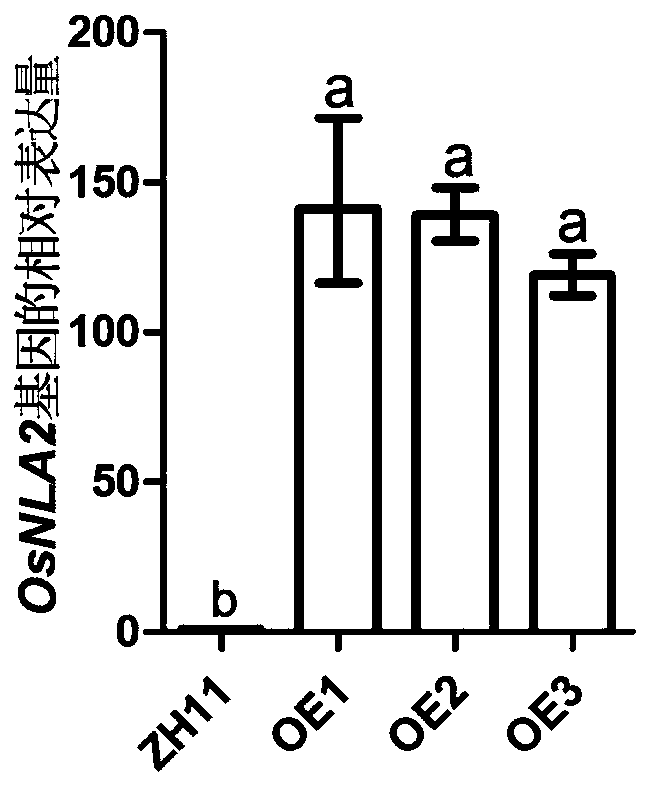Ubiquitin ligase gene OsNLA2, protein and application of ubiquitin ligase gene OsNLA2 in rice selection
A technology of ubiquitin ligase and gene, applied in the direction of ligase, application, genetic engineering, etc., can solve the problems of rice seed and plant growth and development without any research
- Summary
- Abstract
- Description
- Claims
- Application Information
AI Technical Summary
Problems solved by technology
Method used
Image
Examples
Embodiment 1
[0062] Example 1 Construction of OsNLA2 Gene Overexpression Plants
[0063] Extract the RNA of rice Zhonghua 11 and reverse transcribe it into cDNA, using the primer pair:
[0064] F3: 5'-atggtaccatgaagttcggtgcaatatatgaa-3'(KpnI), SEQ ID NO.3;
[0065] R3: 5'-atggatccaattcccattgacagcatagcctg-3' (BamHI), SEQ ID NO.4;
[0066] After the cDNA of the OsNLA2 gene was amplified by PCR, the overexpression vector OsNLA2-p1306 of the OsNLA2 gene was constructed by connecting (KpnI and BamHI) into the pCAMBIA-1306 vector (the pCAMBIA-1306 vector was purchased from Cambia Company). Agrobacterium EHA105 was used to mediate The method of genetic transformation, the overexpression vector was introduced into the normal rice variety Zhonghua 11.
[0067] Transplant all the obtained transgenic seedlings into baskets with soil, water and fertilize them regularly, and plant them in the field when the seedlings grow about 10cm in height. After the seedlings grow up, extract genomic DNA and ...
Embodiment 2
[0077] Construction of embodiment 2 OsNLA2 gene mutant plant
[0078] Using a single target sequence:
[0079] F6: tgttaagtctgcacctcctgagg, SEQ ID NO.9;
[0080] Using the above-mentioned single target sequence, the gene knockout vector OsNLA2-C of the OsNLA2 gene was constructed (for the method refer to Ma X et al, A robust CRISPR / Cas9 system for convenient, high-efficiency multiplex genome editing in monocot and dicot plants.Mol Plant.2015 , 8(8):1274-1284). The genetic transformation method mediated by Agrobacterium EHA105 was used to introduce the gene knockout expression vector into the normal japonica rice variety Zhonghua 11. The mutant plants were sequenced in the T0 generation, and it was determined that the gene had been knocked out in three lines ( figure 2 ), continue to propagate independently to the T1 generation, and obtain an independent mutant plant line of the OsNLA2 gene. The seed size of the OsNLA2 gene mutant plants was significantly smaller than th...
PUM
 Login to View More
Login to View More Abstract
Description
Claims
Application Information
 Login to View More
Login to View More - R&D
- Intellectual Property
- Life Sciences
- Materials
- Tech Scout
- Unparalleled Data Quality
- Higher Quality Content
- 60% Fewer Hallucinations
Browse by: Latest US Patents, China's latest patents, Technical Efficacy Thesaurus, Application Domain, Technology Topic, Popular Technical Reports.
© 2025 PatSnap. All rights reserved.Legal|Privacy policy|Modern Slavery Act Transparency Statement|Sitemap|About US| Contact US: help@patsnap.com



